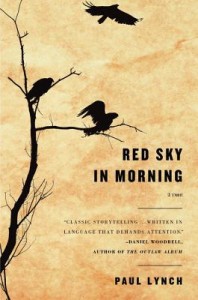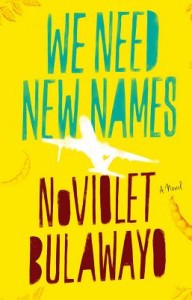 Paul Lynch’s debut novel, Red Sky in Morning (Little, Brown and Company), is a visually stunning, verbally luscious book. It reads like the love child of a painter and a poet. Say, Van Gogh and Dylan Thomas. Or, Cezanne and Seamus Heaney. Lynch uses dense, rhythmically mesmerizing and sometimes obscure language that begs us to pause and linger over each phrase. Yet he couples this stylistic attentiveness with a thriller-like plot of injustice and vengeance, manslaughter and manhunts, the threat of death lurking on every page.
Paul Lynch’s debut novel, Red Sky in Morning (Little, Brown and Company), is a visually stunning, verbally luscious book. It reads like the love child of a painter and a poet. Say, Van Gogh and Dylan Thomas. Or, Cezanne and Seamus Heaney. Lynch uses dense, rhythmically mesmerizing and sometimes obscure language that begs us to pause and linger over each phrase. Yet he couples this stylistic attentiveness with a thriller-like plot of injustice and vengeance, manslaughter and manhunts, the threat of death lurking on every page.
Set in rural western Ireland in the early 1800s, the novel follows Coll Coyle, a small tenant farmer and devoted family man, who flees for his life following the accidental murder of his evil landlord, Hamilton. Hamilton’s bloodthirsty, bloodhound of a henchman, James Faller, and his crew relentlessly track Coyle across the country and eventually the ocean—from the Old World to the New. And once Coyle signs on with a railroad-building crew in Philadelphia, this bleak story becomes bleaker still.
Though many contemporary novels—especially those with an element of suspense—are often described as “cinematic,” my first impression of Red Sky was, truly, that it reads like a film. It seeps its way into our eyes and ears, with wide-angle shots capturing the magnificent menace of an animate landscape. I could imagine every frame, as if I were watching the verbal equivalent of an auteur adventure film, a John Ford Hollywood western or, even more so, a Sergio Leone spaghetti western, such as Once Upon a Time in America (1984).
So when I later discovered that Lynch’s previous career was in film—in fact, that he is often called Ireland’s foremost film critic—I was hardly surprised. The following line, for example, hints at the gorgeous way in which he works with color on the page: “The lime white of the house indigo in the light and he saw himself as a child among gragging geese and his father plastering dripping upon the clay.” I’m reminded of color-saturated films at the dawn of Technicolor, the robin-egg blue dresses of filmmakers like Douglas Sirk.
But use of color is just one component of Lynch’s cinematic prose. The author loves to position an image at the beginning of a sentence and then juxtapose the picture with an action, such as “the splash of water slapping onto hard ground and then he awoke.” Lynch also writes in an idiom of participles, as in “sullen sky coming down to the land and he walked with the fleece around his neck.” This ping ponging of verbs gives the impression of continuous action and captures the sing-song, repetitive speech patterns of an Irish farmer in the nineteenth century.
Naturalism, though, isn’t the intended effect. In an essay on his website, Lynch says he writes in “a new kind of language, a language about language itself.” And in an interview in Publisher’s Weekly, he says he wants to “reinvigorate the novel form,” particularly through his use of language, explaining how “the feel of the words can tell us as much about the world as their meaning.” When I wasn’t sure how a goose could be “gragging,” a corpse “selenic,” or pigs “torpid,” I realized I needn’t rush to the dictionary. Instead, I let the feel of the words guide me. I experienced their pleasure like a delicious meal whose ingredients I couldn’t quite name.
In a profile in The Irish Times, Lynch cites his primary literary influences as Cormac McCarthy, Saul Bellow, Vladimir Nabokov, and John Banville. I can hear Nabokov in Lynch’s verbal gymnastics. McCarthy comes through, too, in Lynch’s mix of rich language and ferocious violence. After Coyle knocks Hamilton dead, he “caught the other man’s brain matter viscous spilling from breached bone, and he tried to push it back in with his hands whimpering softly to himself oh Jesus.” The first meal in the book is blackened stew made from the blood obtained by cutting open a live calf’s vein at the base of its neck, then sewing it up. The next is an eel speared with a pike and gnawed on raw.
Dabbling in incest, torture, and cholera, this is not a dainty book, despite its lovely words. The lyrical language mixed with gut-wrenching (or brain-spilling) subject matter creates a powerful tension: we drift off in sublime reverie, while clutching our stomachs at the same time. Making this even more profound is the way in which violence and tenderness are so closely linked. When Coyle cut the animal’s throat for the blackened stew, he then “stayed whispering to it like it was a lover,” helping it recover from the wound.
The danger of this overly attentive language, of course, is that poetics sometimes comes at the expense of clarity. The point of view shifts often enough that I was occasionally confused by the overuse of pronouns, and I sometimes had to read a section twice to understand what had actually occurred. I never regretted the re-read, though, because Lynch’s passages merit multiple visits. Still, there are moments where story is secondary to sensory experience.
Lynch created a media buzz when he signed a six-figure, two-book deal as a debut novelist (Red Sky was acquired by Quercus in the U.K. after a bidding war and subsequently published to critical acclaim in April; the U.S. edition is being published by Little, Brown and Company and was released in November). So it is heartening to hear that work so language-centered, so rich and poetic, which requires concentration and attention to each word, might be hailed by the market. No doubt more buzz will appear when Red Sky is (inevitably, I think) turned into a film. I can already see the scenes unfolding—they’ve lingered long since I finished the book.






